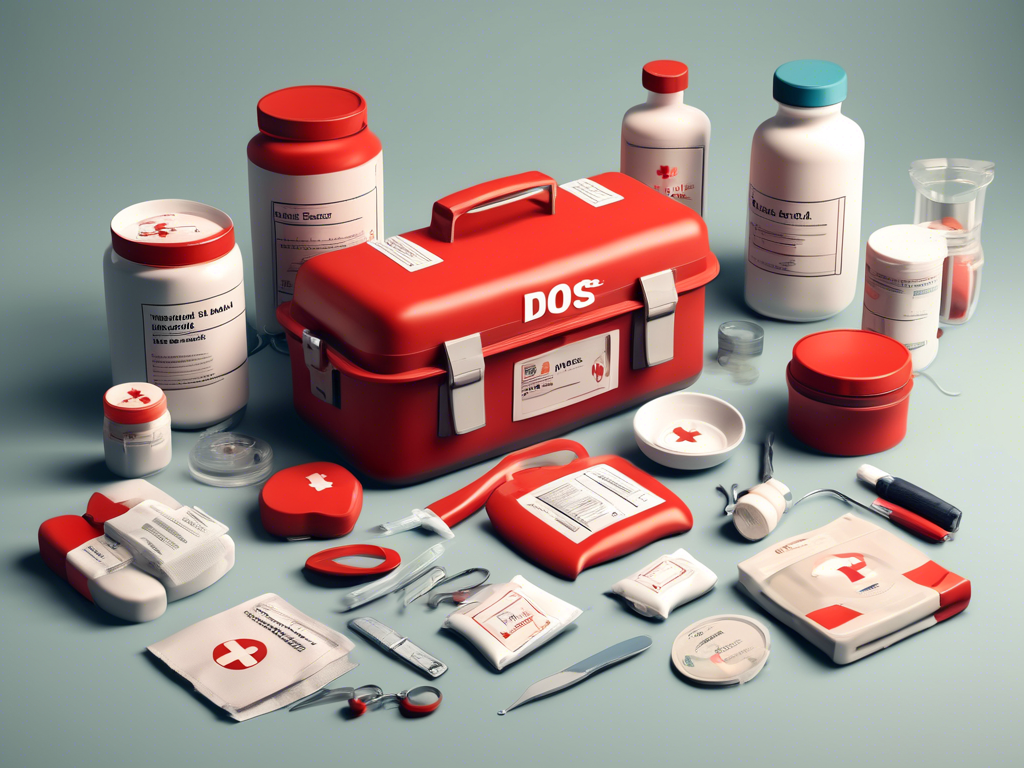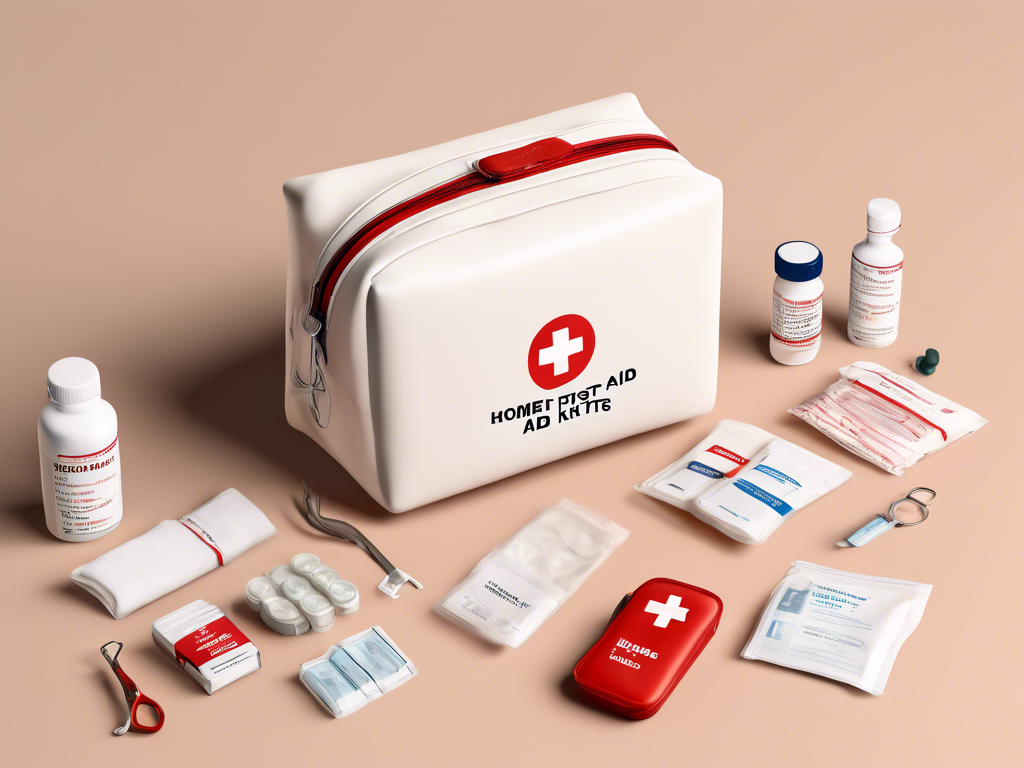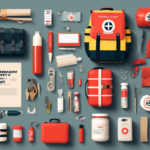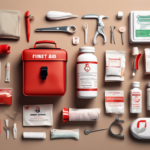In a world where unpredictability reigns, being prepared can make all the difference. Emergencies can strike at any time, whether it’s a minor cut, a sudden allergic reaction, or a more serious incident. This is where a well-stocked home first aid kit becomes an essential tool for every household in 2024. Understanding what to include and how to organize these home first aid supplies can empower families to respond effectively in times of crisis.
As we navigate through the complexities of modern life, the importance of having the right supplies on hand cannot be overstated. The landscape of health risks evolves, necessitating that individuals reevaluate their preparedness strategies regularly. This article serves as a comprehensive guide, providing readers with valuable insights into assembling a home first aid kit that caters to their unique needs. From identifying the top ten must-have items for 2024 to customizing your kit based on your family’s specific requirements, we’ve got you covered.
Ultimately, this article aims to equip you with the knowledge needed to create and maintain an effective home first aid kit, ensuring that you and your loved ones are prepared for whatever life may throw your way.
Top 10 Must-Have Items for Your Home First Aid Kit in 2024

1. Adhesive Bandages
Adhesive bandages are essential for treating minor cuts and abrasions. They come in various shapes and sizes, ensuring you can cover any small wound effectively. In 2024, opt for waterproof variants that stay secure even during activities like showering or swimming. 🩹
2. Antiseptic Wipes
To prevent infections, it’s crucial to have antiseptic wipes in your home first aid kit. These wipes are designed to clean wounds before applying a bandage, helping to reduce the risk of bacteria entering the injury. Look for alcohol-free options suited for sensitive skin. 🧼
3. Gauze Pads and Medical Tape
For larger wounds or those that may bleed more heavily, include gauze pads and medical tape. Gauze pads are available in different thicknesses and sizes, while medical tape helps secure them in place. Always have a variety so you’re prepared for emergencies. 🩹✨
4. Scissors and Tweezers
Having a pair of scissors and tweezers can be incredibly helpful in emergencies. Use scissors to cut gauze or clothing away from an injury, and tweezers for removing splinters or ticks. Be sure they are included in your home first aid supplies! ✂️🪡
5. Pain Relievers
Whether it’s a headache, muscle ache, or minor injury, having pain relievers like acetaminophen or ibuprofen on hand is vital. Always check expiration dates regularly to ensure effective treatment when needed. 💊
6. Instant Cold Packs
To manage swelling and pain from injuries, instant cold packs should not be overlooked. These packs can be activated quickly and provide immediate relief for sprains or strains. They are lightweight and easy to store in your first aid kit. ❄️
7. Thermometer
Monitoring body temperature is essential in case of fevers. A digital thermometer is a quick and reliable choice to keep in your home first aid kit. Consider investing in a non-contact thermometer for added convenience, especially for children. 🌡️
8. Burn Cream or Aloe Vera Gel
Burns can occur unexpectedly, so it’s important to include burn cream or aloe vera gel in your kit. These soothing treatments can help alleviate pain and promote healing for minor burns. Always opt for products with natural ingredients for best results. 🔥
9. Anti-Allergy Medication
Allergies can strike at any moment; therefore, having anti-allergy medication like antihistamines is crucial. This item can help alleviate symptoms from pollen, insect bites, or certain foods and is a must-have in your home first aid supplies. 🌼
10. First Aid Manual
Finally, a first aid manual is an invaluable resource. It provides guidance on how to handle various emergencies, giving you the confidence to act quickly and effectively. Ensure it’s easy to access in your first aid kit for quick reference. 📚
By keeping these essential items in your home first aid kit, you’ll be well-prepared for any minor injuries or health issues that may arise in 2024. Stay safe and proactive! 🏡✨
How to Customize Your Home First Aid Kit to Fit Your Family’s Needs

Assessing Family Members’ Needs
To effectively customize your home first aid kit, begin by assessing the specific needs of your family members. Consider any pre-existing health conditions such as allergies, asthma, or diabetes, and tailor your supplies accordingly. For example, if anyone in your family is prone to allergic reactions, ensure you include extra doses of anti-allergy medication like antihistamines.📋
Including Kid-Specific Supplies
If you have children, your first aid kit will need to address their unique needs. Kids are more prone to minor injuries from scrapes and falls. Here are some kid-specific supplies to consider adding:
– **Fun adhesive bandages** with cartoon characters 🎉
– **Children’s pain relievers** that are safe and easy to administer 💊
– **Burn gel** that’s suitable for kids’ sensitive skin 🔥
By personalizing your kit for younger family members, you’ll be better prepared for unexpected injuries.
Consider Seasonal and Activity-Based Supplies
Seasonal changes and activities your family engages in can influence the contents of your home first aid supplies. For instance, if your family enjoys hiking or camping, include items like insect repellent, snake bite kits, and splint materials. During allergy season, you might want to stock extra anti-allergy medication or saline nasal sprays to combat symptoms. 🌲🏞️
Regularly Update and Rotate Supplies
It’s crucial to regularly update your home first aid kit to ensure all items are current and functional. Check expiration dates on medications and replace any used items after incidents. Create a schedule—perhaps every six months—to review and rotate your supplies. This practice not only keeps your kit fresh but also gives you peace of mind knowing you’re prepared. 🗓️✨
Educate Family Members
Finally, customize your first aid kit by educating family members on how to use the supplies effectively. Hold a family meeting where you walk everyone through the kit and discuss how to handle common injuries. Knowing how to correctly utilize items like a digital thermometer or antiseptic wipes can empower family members to respond confidently in emergencies. 📚👨👩👧👦
The Importance of Regularly Updating Your Home First Aid Supplies

Ensuring Effectiveness and Safety
Regularly updating your home first aid supplies is essential to ensure they remain effective and safe to use. Over time, items can expire or lose their potency, which can compromise their effectiveness when you need them most. For instance, medications like pain relievers and antiseptics have specific shelf lives, and relying on outdated products can lead to inadequate care during an emergency. 🕒
Accommodating New Family Needs
As your family grows or changes, so do your medical needs. Adding new members—such as infants or elderly individuals—requires reevaluating your home first aid kit contents. You might need to include pediatric medications for children or specialized supplies for seniors, such as a blood pressure monitor. Regular updates ensure that your kit reflects the current health needs of all family members. 👶👵
Adapting to Seasonal Changes
Seasonal changes can introduce new risks and health concerns that should be addressed in your home first aid supplies. For example, during peak allergy seasons, it’s wise to stock up on antihistamines, while winter may necessitate items for cold injuries like frostbite creams. Regularly reviewing your supplies allows you to adapt to these changes efficiently. 🌼❄️
Promoting Preparedness and Confidence
Regularly updating your home first aid kit not only keeps it stocked with necessary supplies but also instills confidence in your family’s ability to handle emergencies. When everyone knows what to expect and how to use the kit, they are more likely to act swiftly and effectively in urgent situations. Schedule periodic checks and involve family members in this process to promote preparedness. 💪✨
Creating a Systematic Review Process
Implementing a systematic review process for your home first aid supplies can make upkeep easier. Set reminders every six months to check expiration dates, restock used items, and assess additional needs arising from lifestyle changes. This organized approach ensures that your emergency kit is always ready for any situation that may arise, keeping your family safe and informed. 📅🛠️
Essential Tips for Organizing Your Home First Aid Kit Effectively

Choose the Right Container
A well-organized home first aid kit starts with the right container. Select a sturdy, waterproof box or bag that can protect your supplies from moisture and damage. Look for one with multiple compartments to keep items separate and easy to find. Clearly label the container, so everyone knows it’s a first aid kit and where to find it in times of need. 🧰✨
Group Similar Items Together
Organizing your home first aid supplies by category can streamline access during emergencies. Consider grouping items into sections such as:
– **Wound care** (bandages, antiseptic wipes, gauze pads)
– **Medications** (pain relievers, allergy medicine)
– **Tools** (scissors, tweezers, thermometer)
– **Emergency information** (first aid manual, family medical history)
This method not only simplifies locating items quickly but also helps ensure that nothing is overlooked during restocking. 📋🩹
Utilize Clear Zip Bags
Using clear zip bags is an excellent way to further organize your home first aid kit. Place similar items together in individual bags labeled with their contents. For example, you could have a bag for *wound care* and another for *medications*. This visibility makes it easier to assess what you have at a glance and allows for quick retrieval during an emergency. 👜🔍
Regularly Check and Replace Expired Items
One of the most critical aspects of maintaining your home first aid supplies is regularly checking for expired items. Set a reminder to review your kit every six months. During this check, discard any outdated medications and replace them with fresh supplies. Keeping your kit up-to-date ensures maximum effectiveness when you need it most. 🗓️🚫
Educate and Involve Family Members
For your home first aid kit to be effective, everyone in the household should know its contents and how to use the items. Conduct occasional meetings to educate family members on first aid basics and encourage them to familiarize themselves with the kit. Empowering everyone with knowledge will improve confidence and speed during emergencies. 📚👨👩👧👦
Store in an Accessible Location
Lastly, ensure your home first aid kit is stored in a location that is easily accessible to all family members but out of reach of small children. Ideal spots include a high shelf in a closet or a dedicated drawer in the kitchen. Make sure the entire family knows where it is located so they can respond effectively in case of an emergency. 🏡🔑
Understanding the Dos and Don’ts of Home First Aid Supplies

DO: Regularly Check Your Supplies
One of the best practices when managing your home first aid kit is to regularly check your supplies. Set a reminder every few months to review the contents, ensuring that items are not expired and that you are well-stocked. This includes medications, bandages, and antiseptics. It’s better to be safe than sorry, especially if an emergency arises! 🗓️✅
DON’T: Overlook Special Needs
While standard supplies are essential, don’t forget to consider the unique health needs of your family members. For instance, if someone has allergies or chronic conditions, ensure that your home first aid supplies include medications specifically for their needs, such as epinephrine auto-injectors for severe allergies or inhalers for asthma. Tailoring your kit can make a significant difference in emergencies! 💊🚫
DO: Organize by Category
To maximize efficiency when using your home first aid kit, organize supplies into categories such as:
– **Wound care** (bandages, ointments)
– **Medications** (pain relievers, antihistamines)
– **Tools** (scissors, tweezers)
– **Emergency contacts** (family medical history)
This organization will help you quickly locate what you need during a stressful situation. 📋✨
DON’T: Ignore Expiration Dates
Ignoring expiration dates is one of the biggest pitfalls when it comes to maintaining your home first aid supplies. Medications and certain supplies can become ineffective after their expiration date. Always check regularly, and if you find any expired items, replace them promptly to ensure your kit remains ready for emergencies. 🕒❌
DO: Educate Family Members
Education is key! Ensure that all family members know how to use the items in your home first aid kit. Hold a family session to go through each item and explain its purpose. Familiarity with the contents will increase confidence and preparedness in case an emergency occurs. 📚👪
DON’T: Keep Your Kit Hidden
Finally, while it’s essential to keep your home first aid kit out of reach of small children, it shouldn’t be hidden away where it’s difficult to find. Store it in an easily accessible location known to all responsible household members. This way, everyone will know where to turn in an emergency! 🚪🔑
Home First Aid Kits: A Lifesaver for Emergencies at Home

Understanding the Importance of Home First Aid Kits
Having a home first aid kit is crucial for addressing minor medical emergencies quickly and effectively. These kits are designed to provide immediate care for injuries like cuts, scrapes, or burns while minimizing the risk of complications. In emergency situations, time is of the essence; thus, having a well-stocked kit readily available can be a real lifesaver. 🏥✨
What to Include in Your Emergency First Aid Kit
To ensure your home first aid supplies meet all potential needs, include a comprehensive range of items. Below is a list of essentials you should consider:
– **Adhesive Bandages** for small cuts and blisters
– **Antiseptic Wipes** to prevent infection
– **Gauze Pads** and **Medical Tape** for larger wounds
– **Pain Relievers** like acetaminophen or ibuprofen
– **Thermometer** for fever monitoring
– **Burn Cream** for minor burns
Having these items readily available ensures you’re prepared for common household injuries. 🚑🩹
Where to Store Your Home First Aid Kit
Choosing the right location for your home first aid kit is vital for quick access during an emergency. It should be stored in a cool, dry place that is easily accessible to adults, yet out of reach of young children. Ideal spots include a kitchen cabinet, bathroom shelf, or a high drawer. Ensure that all family members are aware of its location so they can act swiftly when needed. 🏡🔑
Regular Maintenance of Your First Aid Kit
Maintenance is key to ensuring that your home first aid supplies remain effective. Set reminders to check your kit every few months, inspecting for expired items and replacing them as necessary. During these checks, also assess if your family’s needs have changed—for example, if a new baby has joined the household or if someone has developed new allergies. Keeping your kit updated guarantees that you’ll be ready for any situation! 📅🔄
Educating Family Members on First Aid Responses
It’s essential to educate all family members on how to use the items in your home first aid kit. Conduct education sessions where you demonstrate the use of various supplies and explain how to respond in case of injuries. Emphasizing the importance of remaining calm and acting quickly can significantly enhance your family’s ability to handle emergencies. This knowledge not only empowers them but could potentially save lives! 📚👨👩👧👦
Conclusion: Be Prepared for Emergencies
In 2024, ensuring that your home first aid kit is fully stocked, organized, and accessible is more important than ever. With the right supplies and knowledge, you can effectively respond to emergencies, minimizing stress and promoting safety at home. Stay proactive in maintaining your kit—it could be a true lifesaver when you need it most. 💪🏽✨
Common Misconceptions About Home First Aid Kits Debunked

Myth: A Home First Aid Kit Is Only for Major Injuries
Many people believe that home first aid kits are only necessary for treating major injuries like deep cuts or fractures. This is a misconception! In fact, these kits are essential for addressing minor injuries too, such as cuts, scrapes, and burns. Keeping a well-stocked kit allows you to manage everyday mishaps effectively and prevent more serious health issues from developing. Remember, timely care can make a significant difference! 🩹✨
Myth: All First Aid Supplies Are the Same
Another common myth is that all home first aid supplies are interchangeable. However, each item serves a unique purpose and should be chosen carefully. For instance, not all bandages work for every type of injury. Waterproof bandages are great for protecting small cuts during showers, while sterile gauze pads are designed for larger wounds that require more absorption. Tailoring your first aid kit to include diverse items reflects your family’s needs better. 📋🔍
Myth: You Don’t Need a First Aid Manual
Some might think that a first aid manual is outdated or unnecessary, especially with so much information available online. However, having a printed manual in your home first aid kit is critical. During emergencies, stress can hinder our ability to recall important procedures. A hard copy provides quick, accessible guidance when it matters most, ensuring everyone knows what steps to take, whether it’s treating sprains or performing CPR. 📚🏥
Myth: Expired Supplies Are Still Safe to Use
A dangerous misconception is that expired supplies remain effective. Many people overlook expiration dates on medications and supplies in their home first aid supplies. After expiration, the efficacy of these products may diminish, putting individuals at risk during emergencies. Regularly checking for expired items and replacing them ensures your kit is always ready for action! 🕒❌
Myth: Once You Build Your Kit, You’re Done
Lastly, some believe that creating a home first aid kit is a one-and-done task. In reality, maintaining your kit is an ongoing process. Your family’s needs may evolve over time due to lifestyle changes, new medical conditions, or growing children. Regular reviews and updates of your supplies and any specific needs are crucial to ensure your kit remains effective and versatile. Schedule periodic checks at least twice a year! 📅🔄
Conclusion: Stay Informed and Prepared
Debunking these misconceptions helps ensure that your home first aid kit is practical, effective, and tailored to your family’s needs. By keeping well-informed and regularly updating your supplies, you can maximize safety and preparedness in your household. Remember, a well-stocked kit could be a true lifesaver! 💪🏽✨
Budget-Friendly Options for Assembling Your Home First Aid Kit

DIY Solutions for Key Supplies
Creating a home first aid kit doesn’t have to break the bank. Many essential items can be crafted at home or bought in bulk to save money. For instance, you can make reusable ice packs by filling zip-lock bags with water and freezing them. Additionally, you can purchase generic versions of medications like pain relievers and antiseptics, which are often just as effective as name brands but significantly cheaper. 💰❄️
Utilize Dollar Store Finds
Don’t overlook dollar stores when shopping for home first aid supplies. These stores typically carry various medical essentials such as adhesive bandages, antiseptic wipes, gauze pads, and even scissors at very affordable prices. Building your kit from dollar store finds allows you to stock up without overspending while ensuring you have everything needed for minor injuries. 🛒🏷️
Repurpose Household Items
Many items you already have at home can double as first aid supplies. For instance, clean cotton t-shirts or dish towels can serve as makeshift bandages, while empty spray bottles can be repurposed to store homemade antiseptic solutions. By using what you have, you can effectively maximize your budget while assembling a comprehensive home first aid kit. 🏡✨
Group Purchases with Neighbors
Consider collaborating with neighbors or friends to buy home first aid supplies in bulk. Many online retailers offer discounts on larger quantities, allowing you to split costs on items such as adhesive bandages, gauze pads, and pain relievers. This group purchasing method not only saves money but also ensures everyone has access to quality first aid supplies. 🤝💬
Online Deals and Discounts
Keep an eye out for deals on online platforms that specialize in medical supplies. Websites often provide discounts for first-time buyers or seasonal sales. Signing up for newsletters can also alert you to flash sales, helping you snag high-quality home first aid kit items at lower prices. Don’t forget to compare prices between retailers to ensure you’re getting the best deal! 🖥️💸
Prioritize Essentials Over Extras
When assembling your home first aid kit, focus on essential supplies first. While it’s tempting to include every possible item, prioritize must-have materials such as bandages, antiseptics, and pain relievers. Once you have the basics covered, you can gradually add extras as your budget allows—ensuring your kit is both functional and affordable from the start. 🛑🩹
Your Guide to Choosing the Right Storage for Home First Aid Supplies

Selecting the Ideal Container
Choosing the right container is crucial for your home first aid kit. Look for a sturdy, waterproof box or bag that can withstand wear and tear. It should have compartments to organize supplies effectively. A clear, labeled container helps everyone in the household quickly identify where the first aid supplies are located, ensuring you can act fast in emergencies. 🧰✨
Consider Accessibility
Storing your home first aid supplies in an easily accessible location is vital. Choose a spot that adults can reach easily but keep it out of the reach of small children. Popular choices include high kitchen shelves, a dedicated cabinet, or even a drawer in the living room. Make sure all family members know where to find it so they can respond without delay during an emergency. 🏡🔑
Organizing Your Supplies Efficiently
Once you have your container, think about how to organize your home first aid kit efficiently. Group items by category for easy access. Here’s a simple way to categorize:
– **Wound care** (bandages, antiseptic wipes)
– **Medications** (pain relievers, antihistamines)
– **Tools** (scissors, tweezers)
– **Important information** (first aid manual, emergency contact numbers)
This organization method makes it easier to find items quickly, especially when stress levels are high. 📋🩹
Using Clear Zip Bags for Organization
Utilizing clear zip bags can enhance organization within your home first aid supplies. Place similar items in labeled bags, such as one for **wound care** and another for **medications**. This visibility ensures that you can see what’s inside at a glance and helps with quick retrieval during emergencies, reducing any fumbling around in stressful situations. 👜🔍
Keeping Supplies Up-to-Date
Regular maintenance of your home first aid kit storage is crucial for ensuring that your supplies are current. Set reminders every few months to check expiration dates on medications and remove any outdated items. This practice keeps everything fresh and effective—important for your family’s safety when emergencies arise. 🗓️➕
Summing up
In conclusion, understanding the essentials of a home first aid kit is crucial for ensuring safety within your household. We have explored the top ten must-have items to include in your kit, the importance of customization according to your family’s needs, and the necessity of regularly updating your home first aid supplies. Organizing your kit effectively not only enhances accessibility but also ensures that vital resources are readily available during emergencies.
Moreover, addressing common misconceptions about home first aid kits and exploring budget-friendly options further empowers readers to take charge of their health and safety. By choosing the right storage solutions, everyone can create a practical yet efficient kit tailored to their unique circumstances.
As we move further into 2024, the call for emergency preparedness has never been more significant. Every individual can play a role in safeguarding their family against unforeseen events. So gather your supplies, customize your kit, and keep it updated, because when an emergency strikes, the best response is being prepared. Take action today, and let your home first aid kit be a testament to your commitment to safety!



